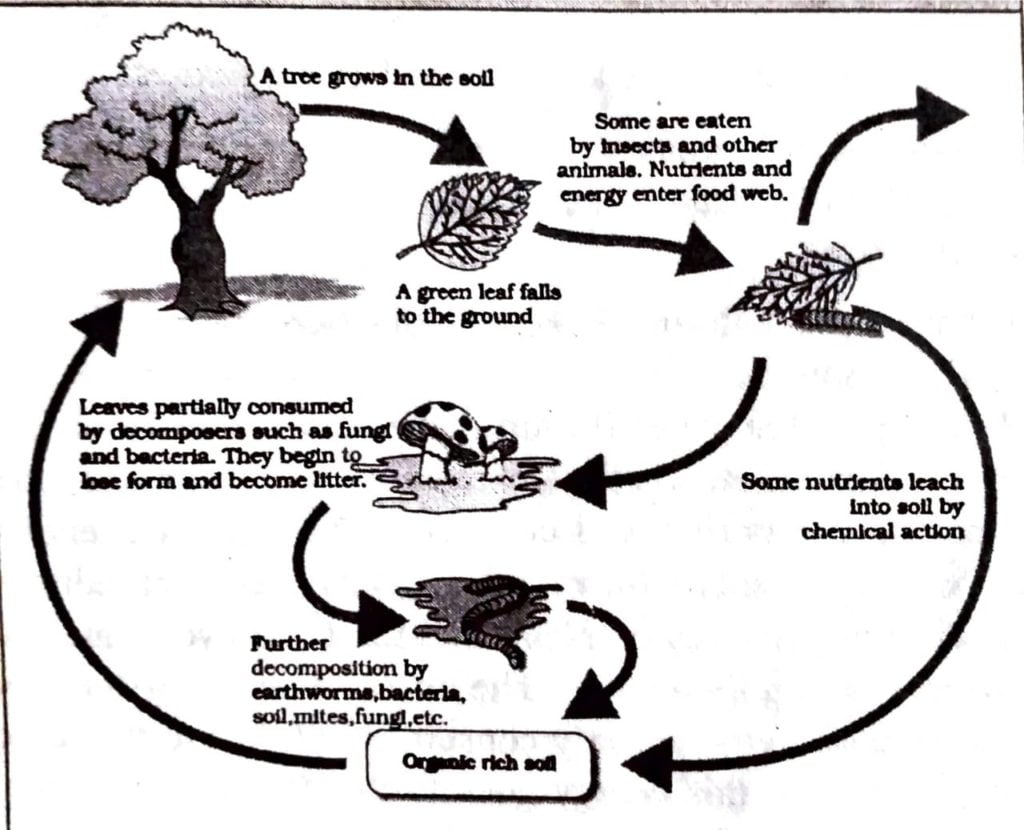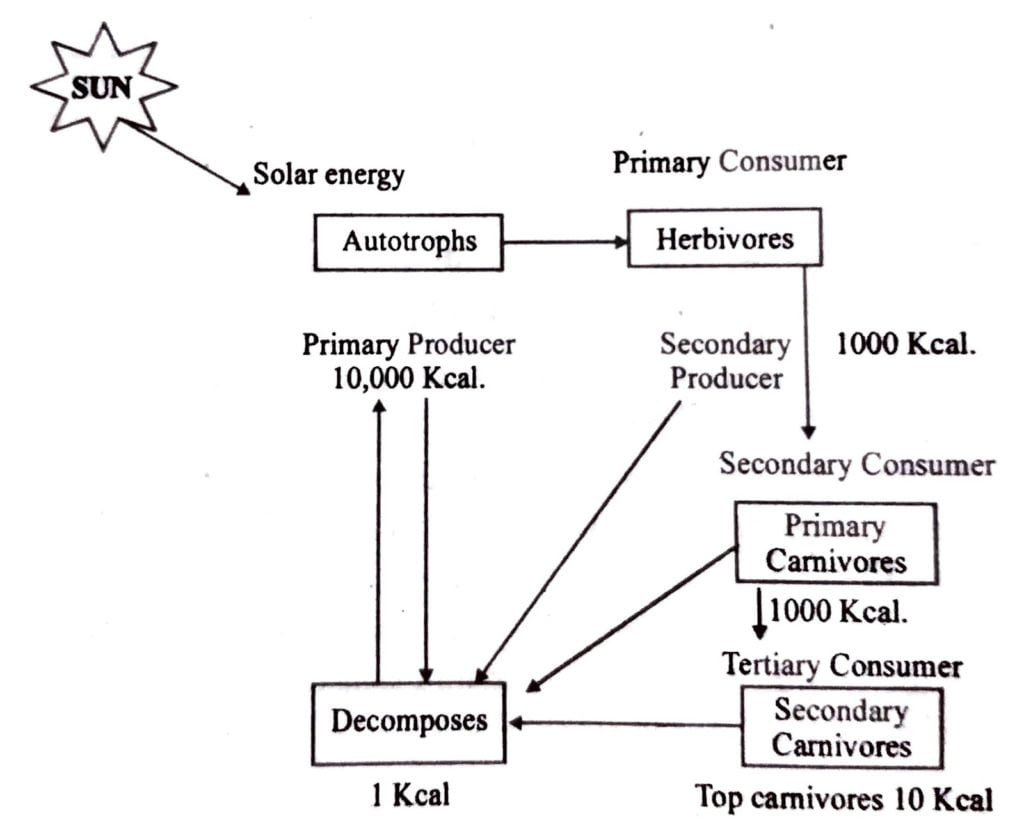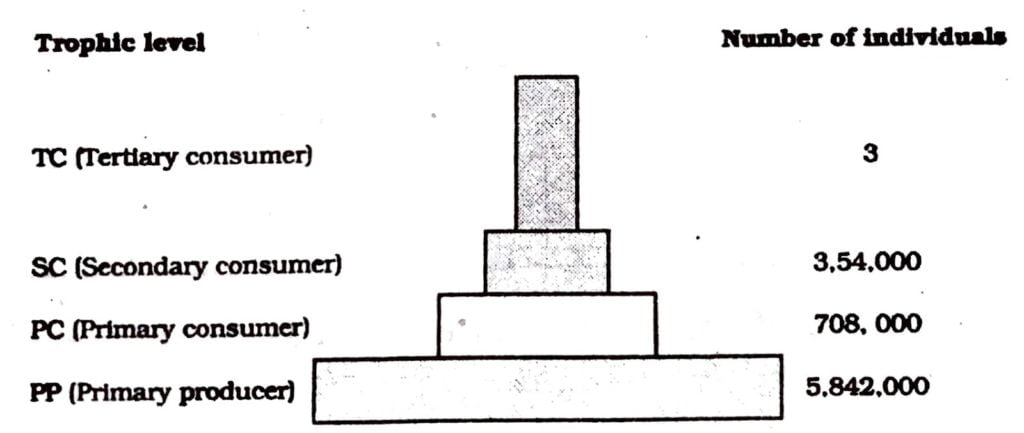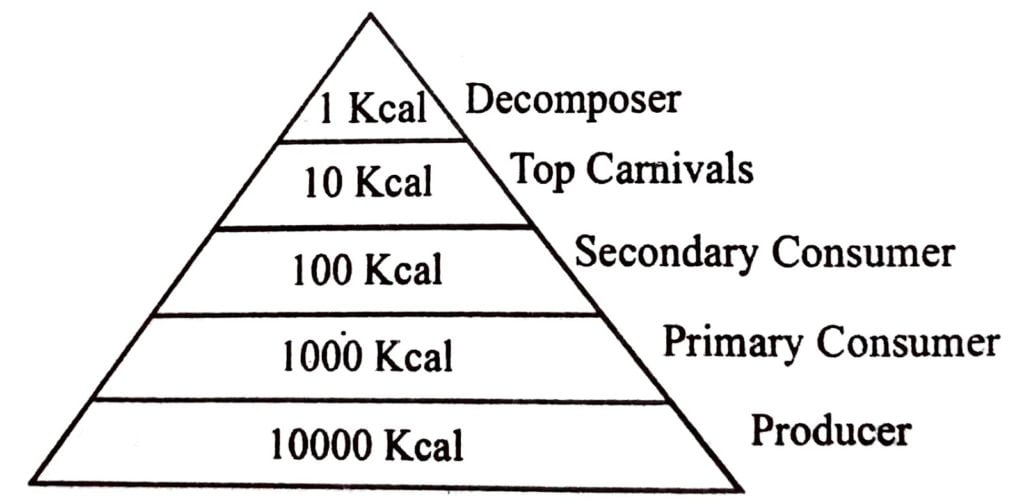Class 12 Biology Chapter 14 Ecosystem The answer to each chapter is provided in the list so that you can easily browse through different chapters Assam Board HS 2nd Year Biology Chapter 14 Ecosystem Question Answer.
Class 12 Biology Chapter 14 Ecosystem
Also, you can read the SCERT book online in these sections Solutions by Expert Teachers as per SCERT (CBSE) Book guidelines. These solutions are part of SCERT All Subject Solutions. Here we have given Assam Board Class 12 Biology Chapter 14 Ecosystem Solutions for All Subjects, You can practice these here.
(F). Long Answer Question (5 Marks Each)
Q.1. Why is the pond regarded as a classic example of ecosystem? Explain pond as an example of ecosystem.
Ans : A pond represents a perfect ecosystem. Producers, consumers and decomposers are all present in the pond. All inorganic substances which support the producers are also available in a pond. The major component of a pond ecosystem can be divided into two types-
(a) Abiotic component. and
(b) Biotic component.
(i) Abiotic Component : The sunlight, water, oxygen, carbon dioxide and minerals such as nitrogen, phosphorus, sulphur, calcium etc. represent abiotic substances available in a pond. Various cyclic process like carbon cycle, oxygen cycle, nitrogen cycle etc. continue in the pond ecosystem which help to maintain link between abiotic and biotic components.
(ii) Biotic Components : It can be divided into –
(a) Producers : The major producers in a pond ecosystem is represented by phytoplanktons like chlamydomonas. Euglena, rudorina etc. which produces food. These converts solar energy to chemical energy.
(b) Consumers :
(i) The primary consumers are represented by minute floating zooplanktons like water fleas, nymphs and larvae of insects etc.
(ii) The secondary consumers include crustaceans, rotifers, small fishes etc.
(iii) The top carnivores are represented by large fishes, fish eating birds, crocodiles etc.
(c) Decomposers : The decomposers are the various types of microorganisms and the detritus animals like protozoa etc. living in mud near or bottom of the pond and break down the organic matter. im From the above description it is evident that the food chain starting from the producer runs through various trophic levels. In this way a pond represents a classic example of ecosystem.
Q.2. What is decomposition? Explain the process of decomposition.
Ans : The process of breaking down of complex organic matter into inorganic matter or substances like carbon dioxide, water and nutrients is known as decomposition.
The raw materials for the process of decomposition includes dead plant remains such as leaves, bark, flowers and dead remains of animals, including fecal matter also known as detritus. The important steps in the process of decomposition are fragmentation, leaching, catabolism, humification and mineralisation.
Detritivores like earthworm break down detritus into smaller particles by a process known as fragmentation.
Leaching leads water soluble inorganic nutrients to go down into the soil horizon and get precipitated as unavailable salts.
Bacterial and fungal enzymes degrade detritus into simpler inorganic substances by the process of catabolism.
Humification and mineralisation occur during decomposition in the soil. Humification leads to accumulation of dark coloured amorphous substance called humus which in nature serves as reservoir of nutrients. This humus is further degraded by some microbes and release of inorganic nutrient occur by a process which is known as mineralisation.
Decomposition is largely an oxygen requiring process the rate of which is controlled by chemical composition of detritus and climatic factors. Warm and moist environment favour decomposition whereas low temperature and anaerobiosis inhibit decomposition resulting in build up of organic materials.

Q.3. How energy flow occurs in an ecosystem? Depict the energy flow through necessary diagrammatic representation.
Ans : Sun is the only source of energy for all ecosystems on Earth. Plants fix this solar energy to make food and all organisms are dependent on plant directly or indirectly. So here the flow of energy occurs from the source of plants, then plants to consumers and after this to the consumers. This is known as energy flow in ecosystem.
The dimension of energy flow in an ecosystem depends on some features :
(i) Sun is the source of all energy : The solar energy is transformed to light energy, chemical energy and heat energy. The green plants absorb light energy which is transformed to chemical energy and producers to consumers and then to the decomposers. Only 1-5 percent of the total light energy falling on plants is used for photosynthesis.
(ii) Energy flow in ecosystem follows the laws of Thermo dynamics : The fixation and utilization of solar energy by the green plants in the form of food obey two laws of Thermodynámics-
According to the first law of thermodynamics energy cannot be created or destroyed. It can only be transformed from one form to another.
The second law of thermodynamics states that every transformation of energy is accompanied by a simultaneous degradation of energy from concentrated form to dispersed form. That is at each step of conversion some energy is lost as heat energy.
The potential energy used by producers and consumers for metabolic lurks is transformed into heat energy.
(iii) Unilateral flow of energy and its stepwise degradation: After the conversion of solar energy by producers and consumers in different forms it cannot return the solar energy. Hence it can be said that the energy once acquired cannot be sent back to its source again. The flow of energy is unidirectional.
The green plants conserves only 10 present of the total solar energy it receives as net primary production and the rest is lost as heat energy. The primary,net production is used by consumer but 90 percent of it is lost again as heat energy and 10 percent is incorporated in the body of the primary consumer as net energy. Thus in the successive levels the energy available goes on decreasing.
The energy accumulation in various trophic level may be illustrated as follows :
Producers – First level – Second level – Third level
consumers consumers consumers
1000 KCal → 100 KCal : 10K Cal : 1KCal
This may form a pyramid of energy.

Q.4. What do you mean by an Ecosystem? Describe the different components of an Ecosystem.
Ans : A natural unit comprising of living and non-living components, interacting and exchanging materials between them forms a self-dependent and adaptable system known as ecological system or ecosystem.
The main components of an ecosystem can be classified as :
(i) Biotic : Includes all the living organisms.
(ii) Abiotic : Includes all the nonliving components of an ecosystem.
(iii) Biotic component : These are as follows :
(a) Producers : These are the green plants which trap solar and convert it to potential chemical energy. These are also known as autotrophs.
(b) Consumers : All animals and non-green plants which directly or indirectly depend upon the producers for energy from the food.
(c) Decomposers : These include all micro-organisms which cause decomposition of the dead remains of the plants and animals and utilise a part of the product of decomposition and release the rest of it for use by the producers. Here the decomposers decomposes organic substances to simpler inorganic form.
(ii) Abiotic factors : The major abiotic factors of an ecosystem includes air, water, soil, light, temperature.
(a) Air : Air is essential part of an ecosystem. Air means O₂ CO₂, N₂ and other essential components for life. Air should be pure.
(b) Water : Water is the major constituent of supporter of protoplasm and in an ecosystem water may be present in liquid, vapour and in solid form.
(c) Light : Light is another limiting factor of an ecosystem. It is essential for the growth, development and for the distribution of some animals and plants.
(d) Temperature : It is also most essential regulating factor for plants and animals in an ecosystem.
Q.5. What is ecological pyramid? Explain different types of pyramids with necessary diagrams.
Ans : The interrelationship between the successive food levels may be expressed in terms of number of individuals, biomass, energy flow etc. In graphical form called ecological pyramid.
The ecological pyramids are of 3 types :
(a) Pyramid of number.
(b) Pyramid of energy.
(c) Pyramid of biomass.
(a) Pyramid of number : It is the graphic representation of the number of individual organisms in different trophic levels of a food chain.

The pyramid of number may be upright as shown or it may be inverted as in a tree ecosystem. In a tree ecosystem, the producer is represented by the single tree.A number of insects inhabit the tree and derive their nutrition from these. A good number of birds feed on the insects.
(b) Pyramid of energy : In terms of energy, the base i.e. producers contains maximum and it is gradually reduces from producer level to decomposer level. It follows the 10 percent law. Only 10 percent of energy is flowing from one trophic level to the next. In this way a upright pyramid is formed.

(c) Pyramid of Biomass : Energy from food received from the lower trophic level is conserved as biomass which in turn eaten by the organisms of the next higher trophic level. It is, therefore, the biomass of all individuals. of the trophic level. Consequently, the number of individuals decreases. It may be inverted pyramid.

Q.6. Explain in brief the process of ecological succession bare rocks.
Ans : On a baren rock, the primary succession results the invading of the pioneer species which are lichens. The lichen are called the primary succession. Over the lichen, bryophytes and then forms and then other trees are growing resulting climax community. The formation climax community i.e. forest in a baren rock iş called ecological succession. The rock i.e. xerophytic habitat is now getting converted into the mesophytic environment.
Q.7. Write about the ecosystem services.
Ans : A wide range of economic, environmental and aesthetic benefits provided to the human beings by ecological processes of an ecosystem are collectively called ecosystem services.
Services of a healthy forest ecosystem :
(i) Forest provides food in the form of root, tuber, leaves, fruits etc.
(ii) Forest provides fuel in the form of wood for cooking and keeping warm.
(iii) Forest provides timber for building purposes of house, ship, railway, sleeper, sport items etc.
(iv) Forest also provides a number of useful products like camphor, essential oils, tennis, dyes, gums, resins, soap, drugs etc.
(v) These keep the environment cool by regulating the transpiration and precipitation.
(vi) These provides shelter to a variéty of animals.
(vii) They produce more oxygen the other organisms by the process of photosynthesis.
(viii) These prevent roil erosion and helps in soil conservation.
Give One Word Technical Term: (Special 1 Mark Questions)
Q.1. Group of organisms of one species occupying a definite area.
Ans : Community.
Q.2. A group of organisms belonging to a number of different species.
Ans : Population.
Q.3. A community of organisms, their physical environment interacting as a unit.
Ans : Ecosystem.
Q.4. Green photosynthetic organisms forming the first trophic level.
Ans : Producer.
Q.5. The stored plant energy after respiratory utilization.
Ans : Net Primary Productivity.
Q.6. A series of eating and being eaten.
Ans : Food chain.
Q.7. Network formed by interacting food chains.
Ans : Food.
Q.8. Total mass of organisms- fresh or dry weight.
Ans : Biomass.

Hi, I’m Dev Kirtonia, Founder & CEO of Dev Library. A website that provides all SCERT, NCERT 3 to 12, and BA, B.com, B.Sc, and Computer Science with Post Graduate Notes & Suggestions, Novel, eBooks, Biography, Quotes, Study Materials, and more.


